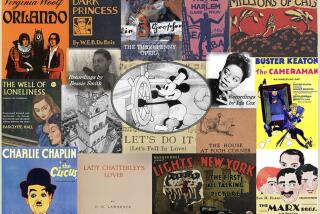Colorization Debate Takes On a New Hue : Analysis
Film colorization used to be such a nice simple debate. Bad guys, good guys, a moral issue, and victims on a conveyor belt being carried toward the jaws of a computer.
On one side, there were people like Ted Turner, twirling their gnarly mustaches and cackling about the evil deeds they planned for some classic black and white American movies. On the other, there were directors and critics whose outrage often erupted in molten invective.
Wednesday, in an event the Directors Guild of America is âhailing as a great victory,â the debate took on a variety of hues itself and the colorization of old films seemed to have been swept aside as a dead issue.
In a report submitted to members of the House Judiciary Committee, the U.S. Copyright Office concluded that the authors of films include not only directors, but most of their collaborators--cinematographers, art directors, editors, actors--and recommended legislation that if enacted will only affect films made after it is passed.
The Copyright Office report, titled âTechnological Alterations to Motion Pictures,â was conducted at the request of a House subcommittee and may form the basis for federal âartistsâ moral rightsâ legislation that could be introduced in Congress within weeks. The fact that the report said there is âmeritorious public purposeâ to protecting the integrity of film works was called ârevolutionaryâ by Elliott Silverstein, who heads the Directors Guild committee lobbying for a moral rights bill.
âThe report does say there should be a moral rights law,â Silverstein said. âIt does say that the Copyright Office will support moral rights legislation. After two years of being told by various people in the establishment that we donât have a case, weâve now been told that we do.â
The phrase moral rights , as used by the directors, refers to the right of film makers to approve any changes made in their completed pictures.
Silverstein discounted the qualifiers placed on the Copyright Officeâs conclusions. He said the objective from the beginning has been to win moral rights for film makers, and that the report is the first formal acknowledgement by a government department of those rights.
âWeâve never opposed colorization, or any of the alterations done to films,â Silverstein said. âWhat weâve opposed is doing those things without the permission of the film makers. Colorization was never the issue; the issue is moral rights.â
Silverstein added that the directors are not giving up the fight against the colorization of old movies, and said he doesnât think the reportâs conclusion that moral rights be extended to other members of film crews will make it into the language of the bill.
â(The Copyright people) donât understand enough about pictures, they donât understand the process, so they say, âLetâs give it to everybody,â â Silverstein said. âWeâll resolve that sort of thing in hearings.â
Silverstein said he was also encouraged by the response of the Motion Picture Assn. of America, the Washington-based office that represents the interests of the film industry establishment and which is opposed to moral rights legislation. In a prepared statement, the MPAA reiterated its belief that the âcurrent collective bargaining system is the best way to protect both the rights of the creative artist and the ability of motion picture producers to serve consumers.â
There are many nuances to the directorsâ campaign on Capitol Hill, but the stakes are clear enough. What the directors are hoping for is a bill that gives them the same statutory power that their counterparts have in most European countries, the right to approve or disapprove any changes made in their completed films.
In those countries, film is an acknowledged art form and the laws are meant to protect both the artists and their citizensâ cultural heritage. But the American film industry is not set up to contribute to the countryâs cultural heritage; it is a going concern, and art is an occasional by-product.
The MPAA was blunt on that point in Wednesdayâs statement, saying âthe American film industry is supreme throughout the world,â while those countries that have government-enforced moral rights laws âfind their film industries in a state of decline.â
There are only 15 months to the expiration of the directorsâ current contract, and just the mention of the collective bargaining in the MPAA statement undoubtedly has the directors wondering. Are the producers hinting that theyâre willing to give some ground on moral rights in order to maintain a status quo on copyright laws? Has the directorsâ anti-colorization campaign been a power grab all along?
Silverstein said that a moral rights law would protect them from future technological vandals, and that directors are merely trying to use the lesson learned from the past.
More to Read
Only good movies
Get the Indie Focus newsletter, Mark Olsen's weekly guide to the world of cinema.
You may occasionally receive promotional content from the Los Angeles Times.










